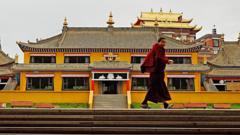Shrouded in crimson robes and whispering under the watchful eyes of the Communist Party, a monk from the Kirti monastery steps forward as the world reflects on a significant milestone—the Dalai Lama's 90th birthday. Located in the heart of Tibetan resistance, this monastery has become a symbol of defiance against the stringent rule imposed by Beijing, with a history steeped in protest and sacrifice.
Over the years, Aba, known as Ngaba in Tibetan, became infamous following incidents of self-immolation and violent clashes, especially during the protests of 2008. Despite heavy investments from China aimed at assimilation, Tibetans living in Aba express deep discontent with growing restrictions on their religious practices and freedoms. The presence of police stations and surveillance indicates the government's ever-watchful gaze.
While the Dalai Lama’s potential succession looms large, his silence in Tibet underscores the oppressive environment under which many monks operate. Recent policies demand that Tibetan children attend state-run schools, further encroaching on their cultural identity, as the language and teachings they once received in their monasteries are now under threat.
As colorful murals and vibrant religious practices remain, the shadow of the Chinese state alters the lives of the Tibetan people. The monk’s poignant remarks reflect a struggle not only for political autonomy but the preservation of a rich heritage. With the Dalai Lama asserting that his successor will emerge beyond Chinese control, the stage is set for a potential conflict over Tibetan identity between forces of cultural preservation and state control.
Amidst the uncertainty, the resilience of the Tibetan people shines through, unyielding in their fight to safeguard their spirituality, sense of self, and the essence of their culture, even in the face of systemic suppression. The question remains: how will these struggles evolve in the coming years, particularly as the presence of strong leadership wanes? Time will tell if the Tibetan spirit—characterized by their rich traditions—can endure beyond the lifetime of its most revered symbol.



















